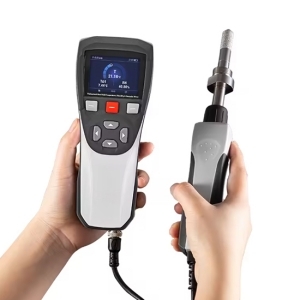A dew point meter is a precision instrument used to measure the moisture content in a gas. It determines the moisture content by measuring the dew point temperature in the air. The dew point temperature refers to the temperature at which the gaseous water in the air needs to drop to reach saturation and condense into liquid water under a fixed air pressure. It is an important indicator for measuring the humidity level of the air and is the balance point between the water vapor saturation and temperature in the air. The dew point temperature is not only important in weather forecasting, but also plays a key role in industrial production, agriculture, and other fields. Therefore, the dewpoint meter also has a wide range of applications. This article will provide you with more information about dew point meters from SISCO online store.
Main Application Areas of Dew Point Meter
In the field of meteorological observation, a portable dew point meter is mainly used to measure atmospheric humidity, providing important data support for weather forecasts and climate research. The high or low dew point temperature is directly related to the possibility of precipitation, so the dew point meter plays a vital role in the deployment of meteorological stations.
In industrial production, a dew point measurement instrument is used to monitor the humidity in industrial processes to ensure stable product quality. Especially in power, petrochemical, pharmaceutical, and other industries, a dew point meter can monitor the humidity level inside the equipment in real-time, providing an important basis for equipment maintenance and management.
In the agricultural field, a dew meter can be used to monitor the environment in the greenhouse, provide the best growth conditions for plants, and improve the yield and quality of agricultural products. In addition, a dew point meter can also be used to monitor the humidity of farmland and provide a suitable environment for crop growth.
In the field of medicine and health, a dew point measuring device is used to monitor the humidity in operating rooms, wards, and other places to ensure that patients are treated in a comfortable environment. At the same time, a dew point meter can also be used for laboratory environment control to ensure the accuracy of experimental results.
In environmental monitoring, a dew point meter can be used to detect atmospheric humidity and provide data support for air quality assessment and pollution control. At the same time, dew point meters can also be used in industrial waste gas treatment, sewage treatment, and other fields to help companies and governments better understand environmental conditions.
Working Principle of Dew Point Meter
The working principle of the dew point meter is based on the relationship between the saturation of water vapor in the air and the temperature. It determines the water vapor saturation in the air by measuring the dew point temperature. During the measurement process, the dew point tester lowers a metal surface to a certain temperature to allow water vapor in the air to condense on the metal surface. Specifically, the dew point meter includes a metal surface, a heater, a sensor, and a microprocessor. The heater is used to increase the temperature, the sensor is used to measure the temperature of the metal surface, and the microprocessor is used to calculate and display the dew point temperature. The dewpoint meter measures the temperature and humidity in the air and uses the principles of thermodynamics to calculate or find the relationship between the saturated water vapor pressure and the relative humidity, thereby determining the dew point temperature in the air.

Sensor Technology
The sensor of the dew point meter is its core component, which is responsible for detecting the water vapor content in the air. Common sensor types include humidity sensors and electronic balances. Humidity sensors can directly measure the number of water vapor molecules in the air, while electronic balances determine the humidity by measuring the weight of water in the air.
Electrical Signal Conversion
The humidity data measured by the sensor is converted into electrical signals, which are then sent to the display through cables or other connections. After the display receives the electrical signal, it converts it into a digital display, so that the user can intuitively understand the dew point temperature in the environment.
Cooling Lens Method
Some high-end dew point meters use the cooling lens method, which uses a cooling device to saturate the air and observe whether water droplets appear in the air through the lens during the cooling process. According to the temperature of the water droplets appearing on the cooling lens, the dew point temperature in the air can be calculated.
Mirror Cooling
Another method is mirror cooling, which involves cooling a mirror in the sample wet air until dew drops (or ice crystals) appear on the mirror surface, and measuring the average temperature of the mirror surface, which is the dew point (frost) temperature. This method requires a high-precision temperature control system and a highly sensitive optical detection system.

